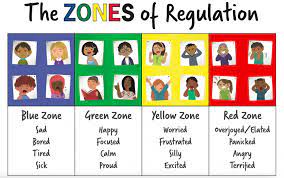The Zones of Regulation

The Zones of Regulation is a complete social-emotional learning curriculum, created to teach children self-regulation and emotional control.
The Zone Colours
The Zones of Regulation uses four colours to help children self-identify how they’re feeling and categorise it based on color.
The curriculum also helps children better understand their emotions, sensory needs, and thinking patterns. They learn different strategies to help them cope and manage their emotions based on which colour zone they’re in.
Additionally, the Zones of Regulation helps children recognise their own triggers, learn to read facial expressions, develop problem solving skills and become more attuned to how their actions affect other people.
The Green Zone
The green zone is used to describe when you’re in a calm state of alertness.
Being in the green zone means you are calm, focused, happy, or ready to learn. This is predominantly the state all children like to be in. It’s also the state most needed in the classroom in order to learn.
The Yellow Zone
The yellow zone describes when you have a heightened sense of alertness. This isn’t always a bad thing, and you typically still have some control when you’re in the yellow zone.
Being in the yellow means you may feel frustrated, anxious or nervous. But, it could also mean you’re feeling excited, silly, or hyper – which is okay in the right situations.
The Red Zone
The red zone describes an extremely heightened state of intense emotions. When a person reaches the red zone, they’re no longer about to control their emotions or reactions. This is the zone kids are in during meltdowns
Being in the red zone means you’re feeling anger, rage, terror, or complete devastation and feel out of control.
The Blue Zone
The blue zone, on the other hand, is used when a person is feeling low states of alertness or arousal.
When you’re in the blue zone you may be feeling down – sad, sick, tired, or bored. You’re still in control, as you are in the yellow zone, but with low energy emotions.
Getting Back to The Green Zone
Along with being able to identify the zones, and know what zone they’re in, your child also needs to know strategies to help them get back to the green zone.
Practicing co-regulation and self-regulation strategies while your child is in the green zone will help them learn the best ways to get back there during times when they’re feeling stressed, frustrated, sad, etc.
Here are some posts to help you get started:
- 119 Emotional Regulation Strategies for Kids
- How to use Breaks to Teach Self-Regulation
- What Should You Put in a Calm Down Kit?
- 10 Ways to Teach Healthy Coping Skills to Kids
- How to Teach Children to Manage Their Anger
ontent
